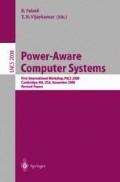Abstract
Power dissipation is a major concern not only for portable systems, but also for high-performance systems. In the past, energy consumption and processor heating was reduced mainly by focusing efforts on mechanical or circuit design techniques. Now that we are reaching the limits of some of these past techniques, an architectural approach is fundamental to solving power related problems. In this work, we use a model of the Alpha 21264 to simulate a high-performance, multipipelined processor with two integer pipeline clusters and one floating point pipeline. We propose a hardware mechanism to dynamically monitor processor performance and reconfigure the machine on-the-fly such that available resources are more closely matched to the program's requirements. Namely, we propose to save energy in the processor by disabling one of the two integer pipelines and/or the floating point pipe at runtime for selective periods of time during the execution of a program. If these time periods are carefully selected, energy may be saved without negatively impacting overall processor performance. Our initial experiments shows on average total chip energy savings of 12% and as high as 32% for some benchmarks while performance degrades by an average of only 2.5% and at most 4.5%.
Access this chapter
Tax calculation will be finalised at checkout
Purchases are for personal use only
Preview
Unable to display preview. Download preview PDF.
References
D. Albonesi, “Dynamic IPC/Clock Rate Optimization,” In the 25 International Symposium on Computer Architecture, Barcelona, Spain, pp. 282–292, June 1998.
D. Brooks, V. Tiwari, and M. Martonosi, “Wattch: A Framework for Architectural-Level Power Analysis and Optimizations,” In the 27th International Symposium on Computer Architecture, Vancouver, BC, June 2000.
Doug C. Burger, Todd M. Austin, and Steve Bennett, “Evaluating Future Microprocessors-The SimpleScalar Toolset,” Technical Report 1308, University of Wisconsin-Madison Computer Sciences Department, July 1996.
T. M. Conte, K. N. Meneses, P. M. Mills, and B. A. Patel, “Optimization of Instruction Fetch Mechanisms for High Issue Rates,” In 22nd International Symposium on Computer Architecture, pp. 333–344, June 1995.
Jeffrey Gee and Mark Hill, Dinoisions Pnevmatikatos, Alan J. Smith, “Cache Performance of the SPEC Benchmark Suite,” IEEE Micro, Vol. 13, Number 4, pp. 17–27 (August 1993).
S. Ghiasi, J. Casmira, and D. Grunwald, “Using IPC Variation in Workloads with Externally Specified Rates to Reduce Power Consumption,” Workshop on Complexity-Effective Design held in conjunction with the International Symposium on Computer Architecture. Vancouver, BC, 2000.
R. E. Kessler, E. J. McLellan and D. A. Webb, “The Alpha 21264 Microprocessor Architecture,” In Proceedings of the International Conference on Computer Design, Austin, TX, 1998.
S. Manne, A. Klauser, D. Grunwald, “Pipeline Gatine: Speculation Control for Energy Reduction,” in Proceedings of the International Symposium on Computer Architecture, Barcelona, Spain, June, 1998.
S. McFarling, “Combining Branch Predictors,” Technical Note TN-36, Digital Equipment Corporation Western Research Laboratory, June 1993. http://research.compaq.com/wrl/techreports/abstracts/TN-36.html.
T. Sherwood, B. Calder, “Time Varying Behavior of Programs,” UCSD Technical Report CS99-630, Department of Computer Science and Engineering, University of California, San Diego, August 1999.
D. W. Wall, “Limits of Instruction-Level Parallelism,” In Proceedings of the Fourth International Conference on Architectural Support for Programming Languages and Operating Systems, pp. 176–188, Boston, MA, 1991.
Author information
Authors and Affiliations
Editor information
Editors and Affiliations
Rights and permissions
Copyright information
© 2001 Springer-Verlag Berlin Heidelberg
About this paper
Cite this paper
Maro, R., Bai, Y., Bahar, R.I. (2001). Dynamically Reconfiguring Processor Resources to Reduce Power Consumption in High-Performance Processors. In: Falsafi, B., Vijaykumar, T.N. (eds) Power-Aware Computer Systems. PACS 2000. Lecture Notes in Computer Science, vol 2008. Springer, Berlin, Heidelberg. https://doi.org/10.1007/3-540-44572-2_8
Download citation
DOI: https://doi.org/10.1007/3-540-44572-2_8
Published:
Publisher Name: Springer, Berlin, Heidelberg
Print ISBN: 978-3-540-42329-4
Online ISBN: 978-3-540-44572-2
eBook Packages: Springer Book Archive

